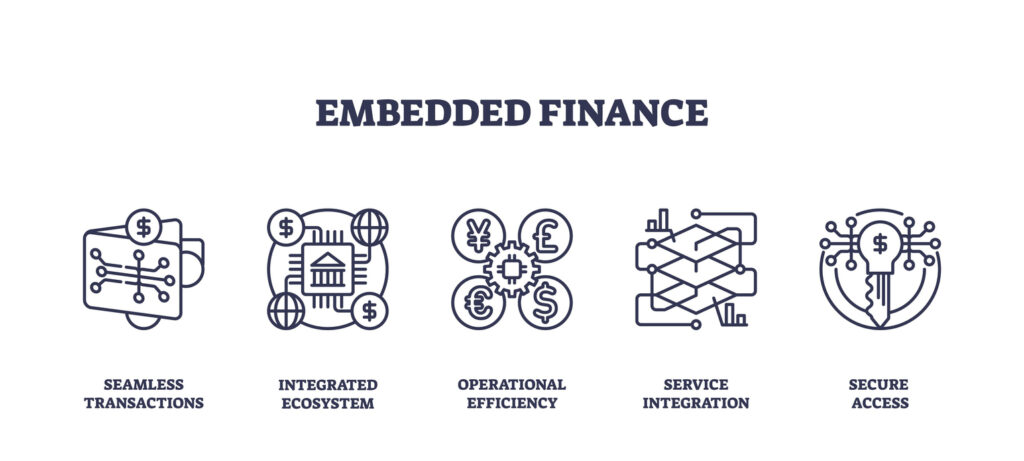The quiet $7 trillion embedded finance revolution
Finance is no longer just a destination; it is now a capability seamlessly integrated into non-financial platforms. As this embedded finance market soars towards a projected $7 trillion value, we explore the key strategies for the banks, fintechs, and brands navigating this quiet revolution.
-
Nikita Alexander
- June 23, 2025
- 4 minutes

The traditional architecture of finance was simple: to access a service, you went to a financial institution. Today, that entire paradigm is being inverted. Finance is no longer a destination but a capability, delivered seamlessly and contextually wherever and whenever a customer needs it. This profound shift is powered by embedded finance, which is the native integration of financial services like payments, credit, and insurance into the digital platforms of non-financial companies.
While it may seem like an incremental innovation, embedded finance is a quiet revolution with a projected market value expected to surpass $7 trillion globally by 2026. It is fundamentally reshaping customer expectations and creating new value chains that challenge the very definition of a financial services provider. For leaders across banking, fintech, and commerce, understanding this trend is no longer optional. It has become a strategic imperative for future growth and relevance.

The Forces Driving the Embedded Finance Boom
The rapid ascent of embedded finance is not a coincidence but the result of a powerful confluence of technological, competitive, and consumer pressures.
First is the dramatic shift in consumer expectations. Conditioned by the frictionless experiences of tech giants like Amazon, modern consumers in the UK and US expect convenience and immediacy. They are no longer willing to be redirected to a clunky banking portal for a loan application; the demand is for integrated, one-click solutions that don’t disrupt their primary journey, whether that’s buying a car or managing business invoices.
Second, the API economy has matured significantly. Sophisticated and secure Application Programming Interfaces (APIs) have broken down the monolithic data silos of traditional banking. This technology acts as the essential plumbing, allowing third-party brands to securely plug banking capabilities directly into their own user experience with proper consent and robust security protocols.
Finally, there is a fierce competitive drive for customer ownership. For non-financial brands, embedded finance is a powerful tool for increasing customer lifetime value. By embedding financial products, these companies not only generate new, high-margin revenue streams, but they also deepen customer relationships. This strategy transforms a simple transactional sale into a long-term financial partnership, significantly boosting customer loyalty.
Real-World Impact Across Industries
While Buy Now, Pay Later (BNPL) is the most visible example, the true scope of embedded finance is far broader, touching nearly every commercial sector.
- SME Finance Reimagined: Consider a UK-based small business using cloud accounting software. By analyzing its real-time cash flow, the software itself can offer a pre-qualified line of credit. The business owner can then review terms and draw down funds in minutes, bypassing the slow, paper-intensive process of a traditional bank loan and gaining capital at the exact moment of need.
- The Future of Insurance: A couple booking a honeymoon through a travel platform can add comprehensive travel insurance with a single checkbox before payment. Though underwritten by a major insurer, the policy is branded and delivered by the travel company, making the process feel like a value-added, natural part of planning, not a grudging separate purchase.
- PropTech and Embedded Mortgages: In the US, property technology (PropTech) platforms are embedding mortgage services. Users searching for homes can now get pre-qualified and apply for a mortgage on the same site, radically streamlining one of the most complex and often stressful consumer finance journeys.
- Embedded Investing: Neobanks and personal finance apps are now embedding investment services, allowing users to purchase fractional shares of stocks or ETFs directly from their main cash account. This lowers the barrier to entry for novice investors and captures more of the customer’s financial life within a single app.
A New Strategic Role for Banks and Fintechs
The rise of embedded finance does not signal the end of traditional banking. Instead, it catalyzes its evolution, creating a critical role for incumbents as the regulated engine behind these experiences through a model known as Banking-as-a-Service (BaaS).
In this ecosystem, established banks provide the foundational, non-negotiable elements: regulatory licenses, robust compliance frameworks, and access to payment rails. This requires a significant cultural shift away from owning the entire customer journey. Agile fintechs, meanwhile, act as the innovation layer, building the APIs and middleware that allow brands to integrate these banking services. It is a model of “co-opetition” where each party plays to its strengths.
BaaS is a vital B2B strategy for banks, helping them overcome legacy technology and acquire customers at scale without exorbitant marketing costs. For fintechs, it allows for rapid growth by partnering with brands that have large, captive audiences. The brand, in turn, owns the customer experience and its valuable data. The institutions that win in this new era will be those that embrace collaboration and focus relentlessly on delivering financial tools that empower customers within the digital experiences they already love.


 Bobsguide is a
Bobsguide is a